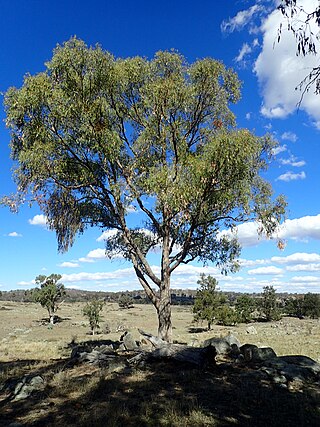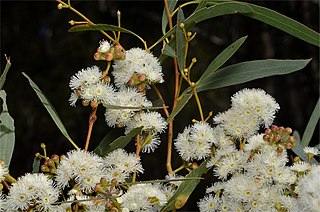
Eucalyptus dalrympleana, commonly known as mountain gum, mountain white gum, white gum and broad-leaved ribbon gum, is a species of tree that is endemic to southeastern Australia. It has smooth bark, lance-shaped adult leaves, flower buds in groups of three or seven, white flowers and cup-shaped, bell-shaped or hemispherical fruit.

Eucalyptus nova-anglica, commonly known as the New England peppermint or black peppermint, is a species of small to medium-sized tree endemic to eastern Australia. It has thick, rough, fibrous bark on the trunk and larger branches, lance-shaped adult leaves, flower buds in groups of seven, white flowers and hemispherical or conical fruit.

Eucalyptus radiata, commonly known as the narrow-leaved peppermint or Forth River peppermint, is a species of tree that is endemic to south-eastern Australia. It has rough, fibrous to flaky bark on the trunk and larger branches, smooth grey bark on the thinner branches, lance-shaped to curved or almost linear leaves, flower buds in groups of eleven to twenty or more, white flowers and cup-shaped, hemispherical or shortened spherical fruit.

Eucalyptus goniocalyx, commonly known as long-leaved box, olive-barked box or bundy, is a species of small to medium-sized tree that is endemic to southeastern Australia. It has rough, fibrous or flaky bark, lance-shaped to curved adult leaves, flower buds in groups of seven, white flowers and cup-shaped, cylindrical or barrel-shaped fruit.

Eucalyptus elata, commonly known as the river peppermint or river white gum, is a species of medium to tall tree that is endemic to eastern Australia. It has rough, compacted bark on the lower trunk, smooth bark above, lance-shaped to curved adult leaves, green to yellow flower buds arranged in groups of eleven to thirty or more, white flowers and hemispherical or shortened spherical fruit.

Eucalyptus oleosa, commonly known as the red mallee, glossy-leaved red mallee, acorn mallee, oil mallee or giant mallee, is a tree or mallee that is native to Australia. The leaves were once harvested for the production of cineole based eucalyptus oil. Eucalyptus cneorifolia is now the predominant strain used in production due to a higher oil content in new growth.

Eucalyptus smithii, commonly known as the gully gum, gully peppermint, blackbutt peppermint, or ironbark peppermint, is a species of medium-sized to tall tree, sometimes a mallee, that is endemic to southeastern Australia. It has rough, compact bark on the trunk, smooth ribbony bark above, narrow lance-shaped adult leaves, flower buds in groups of seven, white flowers and cup-shaped, bell-shaped or hemispherical fruit.

Eucalyptus nitida, commonly known as the Smithton peppermint, is a species of tree or mallee that is endemic to Tasmania. It has varying amounts of loose, fibrous or flaky bark, lance-shaped to curved adult leaves, flower buds in groups of nine to fifteen, white flowers and cup-shaped to hemispherical fruit.

Eucalyptus risdonii, commonly known as the Risdon peppermint, is a species of small tree that is endemic to a small area in southern Tasmania. It has smooth bark, a crown composed mostly of sessile, glaucous, egg-shaped juvenile leaves arranged in opposite pairs. The flower buds are arranged in groups of between nine and fifteen and the fruit are cup-shaped, conical or hemispherical.

Eucalyptus amygdalina, commonly known as black peppermint, is a species of flowering plant that is endemic to Tasmania. It is a small to medium-sized tree with rough bark on park of the trunk, smooth grey to brown bark above, lance-shaped to linear adult leaves, oval to club-shaped flower buds, white flowers and cup-shaped to hemispherical fruit.

Eucalyptus porosa, commonly known as mallee box, Quorn mallee or water mallee, is a species of mallee or a tree that is endemic to southern Australia. It has rough, fibrous or flaky bark on the trunk and larger branches, smooth greyish bark above, lance-shaped adult leaves, flower buds in groups of seven, white flowers and barrel-shaped or shortened spherical fruit.
Eucalyptus croajingolensis, commonly known as the East Gippsland peppermint or Gippsland peppermint, is a species of tree that is endemic to southeastern Australia. It has rough, short-fibrous bark on the trunk and larger branches, sometimes smooth bark on the thinner branches, lance-shaped to curved adult leaves, flower buds in groups of nine or more, white flowers and hemispherical to cup-shaped fruit.

Eucalyptus canaliculata, commonly known as grey gum, is a tree endemic to a small area in New South Wales in eastern Australia. It has smooth, mostly grey bark, lance-shaped to curved adult leaves, flower buds in groups of seven, white flowers and conical or hemispherical fruit.

Eucalyptus leptophylla, commonly known as the March mallee, slender-leaved red mallee or narrow-leaved red mallee, is a species of mallee that is endemic to inland Australia. It has smooth greyish bark, linear to narrow lance-shaped, oblong or curved adult leaves, flower buds in groups of between seven and thirteen, creamy white flowers and cup-shaped, barrel-shaped or hemispherical fruit.
Eucalyptus brassiana, commonly known as Cape York gum, gum-topped peppermint or as karo in PNG is a small to medium-sized tree that is native to northern Queensland and PNG. It has rough, hard, fissured bark on the trunk and smooth greyish bark on the branches, narrow lance-shaped adult leaves, flower buds in groups of seven, white flowers and hemispherical or cup-shaped fruit.
Eucalyptus cajuputea, commonly known as the narrow-leaved peppermint box, is a tree or a mallee that is endemic to South Australia. It usually has rough, flaky bark on the trunk, linear to narrow lance-shaped adult leaves, flower buds arranged in groups of seven to eleven, white flowers and smooth, cup-shaped to barrel-shaped fruit.

Leptospermum coriaceum, commonly known as green tea-tree or mallee teatree, is a shrub species that is endemic to south-eastern and south-central Australia. It has smooth bark on the younger stems, elliptic to narrow egg-shaped leaves, white flowers and woody fruit. The usual habitat is mallee on sand dunes.
Eucalyptus ornans, commonly known as Avon peppermint, is a species of mallee that is endemic to a restricted area in Victoria. It has smooth whitish to grey bark, slightly glossy, bluish green, lance-shaped adult leaves, flower buds in groups of between seventeen and twenty one, white flowers and shortened hemispherical fruit.
Eucalyptus rodwayi, commonly known as the swamp peppermint, is a species of small to medium-sized tree that is endemic to Tasmania. It has rough, fibrous to flaky bark on the trunk and branches, narrow lance-shaped adult leaves, flower buds in groups of between seven and eleven, white flowers and conical to hemispherical fruit.

Leptospermum micromyrtus is a species of spreading shrub that is endemic to higher areas of south-eastern Australia. It has broad, egg-shaped leaves with the narrower end towards the base, white flowers and fruit that remain on the plant at maturity.















